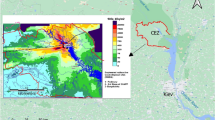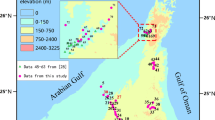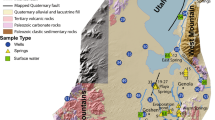Abstract
The San Mateo Creek Basin in New Mexico, USA is located within the Grants Mineral Belt-an area with numerous uranium (U) ore deposits, mines, and milling operations. Six monitoring wells set in an alluvial aquifer near the Homestake Mining Co. Superfund site in the lower San Mateo Creek Basin were logged with a suite of borehole geophysical tools including spectral gamma-ray (SGR), vertically profiled with passive samplers for U and selenium (Se) concentrations, and purged sampled for same constituents. The integrated approach allowed for an assessment on the role of heterogeneity (both physical and chemical) in determining U concentrations in groundwater. Uranium, as measured with SGR logging, is ubiquitous in the alluvial aquifer and the underlying Chinle Group. Aqueous U concentrations appear to be inversely related to thorium (Th) concentrations, as measured by the SGR log, indicating the possibility that U is bound in or adsorbed to clays in the aquifer. The stratigraphy of the alluvium likely plays a role in elevated concentrations of aqueous U. Interbedded clay and sand layers allow for the mobilization of U in oxic sandy layers from U adsorbed in sediments in reduced clay layers. The stratigraphy also plays a role in the degree of mixing of groundwater in the formation and well. Mixing can obscure the ability to identify U sources. Mixing is exacerbated by the relatively long screens (> 20 ft long or > 6.1 m) of the monitoring wells.








Similar content being viewed by others
References
Alam MS, Cheng T (2014) Uranium release from sediment to groundwater: influence of water chemistry and insights into release mechanisms. J Contam Hydrol 164:72–87. https://doi.org/10.1016/j.jconhyd.2014.06.001
American Society of Testing and Materials (ASTM) (2004) Standard guide for conducting borehole logging—mechanical caliper. American Society of Testing and Materials (ASTM) D 6767–97, p 6
American Society of Testing and Materials (ASTM) (2007) Standard guide for planning and conducting geotechnical borehole geophysical logging. (ASTM) D5753
American Society of Testing and Materials (ASTM) (2010) Standard guide for conducting borehole geophysical logging – Gamma. (ASTM) D6274–10
Bailey RT, Hunter WJ, Gates TK (2012) The influence of nitrate on selenium in irrigated agricultural groundwater systems. J Environ Qual 41(3):783–792
Balistrieri LS, Chao TT (1990) Absorption of selenium by amorphous iron oxyhydroxide and manganese dioxide. Geochim Cosmochim Acta 54:739–751
Basu A, Brown S, Christensen JN, DePaolo DJ, Reimus PW, Heikoop JM, Woldegabriel G, Simmons AM, House BM, Hartmann M, Maher K (2015) Isotopic and geochemical tracers for U(VI) reduction and U mobility at an in situ recovery U mine. Environ Sci Techn 49(10):5939–5947. https://doi.org/10.1021/acs.est.5b00701
Boult KA, Cowper MM, Heath TG, Sato H, Shibutani T, Yui M (1998) Towards and understanding of sorption of U(VI) and Se(IV) on sodium bentonite. J Contam Hydrol 35:141–150
Brookins DG (1977) Uranium deposits of the Grants Mineral Belt: geochemical constraints on origin. Exploration Frontiers of the Central and Southern Rockies. Mineral Deposita 17:337–352
Canadian Well Logging Society (2013) LAS information–Log ASCII Standard (LAS) software. http://www.cwls.org/las_info.php. Accessed 13 May 2013
Century Geophysical LLC (2017) http://www.century-geo.com/. Accessed 22 Feb 2018
Dong W, Brooks SC (2006) Determination of the formation constants of ternary complexes of uranyl and carbonate with alkaline earth metals (Mg2+, Ca2+, Sr2+, and Ba2+) using anion exchange method. Environ Sci Techn 40(15):4689–4695. https://doi.org/10.1021/es0606327
Dubrosvky NM, Neil JM, Fugii R, Oremland RS, Hollibaugh JT (1990) Influence of redox potential on selenium distribution in ground water, Medota Western San Joaquin Valley, California. US Geol Sur Open-File Report 90–38:24
Ehrenberg SN, Svånå TA (2001) Use of spectral gamma-ray signature to interpret stratigraphic surfaces in carbonate strata: an example from the Finnmark carbonate platform (Carboniferous-Permian), Barents Sea. Am Assoc Pet Geol Bull 85(2):295–308. https://doi.org/10.1306/8626C7C1-173B-11D7-8645000102C1865D
Fabricius ID, Fazladic LD, Steinholm A, Korsbech U (2003) The use of spectral natural gamma-ray analysis in reservoir evaluation of siliciclastic sediments: a case study from the Middle Jurassic of the Haral Field, Danish Central Graben. Geol Soc Denmark Greenl Bull 1:349–366
Gallaher BM, Cary SJ (1986) Impacts of uranium mining on surface and shallow ground waters, Grants Mineral Belt, New Mexico. New Mexico Environmental Improvement Division, EID/GWH-86/2, p 152
Gallaher BM, Goad MS (1981) Water-quality aspects of uranium mining and milling in New Mexico. In: Wells SG, Lambert W, Callender JF (eds) Environmental geology and hydrology in New Mexico, vol 10. Geological Society Special Publication, Socorro, pp 85–91. http://geoinfo.nmt.edu/publications/nmgs/special/10/. Accessed 1 May 2017
Gates TK, Cody BM, Donnelly JP, Herting AW, Bailey RT, Price JM (2009) Assessing selenium contamination in the irrigated stream-aquifer system of the Arkansas River, Colorado. J Environ Qual 28:2344–2356
Hall SM, Mihalasky MJ, Tureck KR, Hammarstrom JM, Hannon MT (2017) Genetic and grade and tonnage models for sandstone-hosted roll-type uranium deposits, Texas Coastal Plain, USA. Or Geol Rev 80:716–753. https://doi.org/10.1016/j.oregeorev.2016.06.013
Harte PT, Blake JMT, Becher KD (2018a) Determination of representative uranium and selenium concentrations from groundwater, 2016, Homestake Mining Company Superfund Site, Milan, New Mexico. US Geol Survey Open-File Report 2018–1055:39. https://doi.org/10.3133/ofr20181055
Harte PT, Blake JMT, Becher KD, Thomas JV, Stengel VG (2018b) Data associated with uranium background concentrations at Homestake Mining Company Superfund site, near Milan, New Mexico, July 2016 through October 2016 (ver. 1.2, September 2018). US Geol Sur data release. https://doi.org/10.5066/F7CR5RJS. Accessed 9 Oct 2018
Helsel DR, Hirsch RM (2002) Statistical methods in water resources. US Geol Sur techniques of water-resources investigations of the United States Geological Survey, Book 4, hydrologic analysis and interpretation, p 524
Homestake Mining Co (2015) Summary and discussion of groundwater background concentrations and groundwater flow for aquifers at Homestake Mining Company’s Grants Reclamation Project, Grants New Mexico, July 2015. Homestake Mining Co. of California, p 110
Hydro-Engineering LLC (2001) Ground-water hydrology for support of background concentration at the Grants Reclamation Site for Homestake Mining Company of California
Kaufman RF, Eadie GG, Russell CR (1976) Effects of uranium mining and milling on ground water in the Grants Mineral Belt, New Mexico. Ground Water J 14(5):296–308
Keys WS (1990) Borehole geophysics applied to ground-water investigations: U.S. Geological Survey Techniques of Water-Resources Investigations book 2, chap. E2, p 150
Klaja J, Dudek L (2016) Geological interpretation of spectral gamma ray (SGR) logging in selected boreholes. Nafta-GAZ, ROK LXXII 1:3–14. https://doi.org/10.18668/NG2016.01.01
Kulp T, Pratt LM (2004) Speciation and weathering of selenium in Upper Cretaceous chalk and shale from South Dakota and Wyoming, USA. Geochim Cosmochim Acta 68(18):3687–3701. https://doi.org/10.1016/j.gca.2004.03.008
Langman JB, Sprague JE, Durall RA (2012) Geologic framework, regional aquifer properties (1940s–2009), and spring, creek, and seep properties (2009–10) of the upper San Mateo Creek Basin near Mount Taylor, New Mexico. US Geol Sur Sci Inv Rep 2012–5019:96
Langmuir D (1978) Uranium solution-mineral equilibria at the temperatures with application to sedimentary ore deposits. Geochem Cosmochim Acta 42:547–569
Martin TD (2003) Determination of trace elements in drinking water by axially viewed inductively coupled plasma-atomic emission spectrometry: U.S. Environmental Protection Agency Report EPA. EPA/600/R-06/115, Revision 4.2, p 36
Masscheleyn PH, Dealune RD, Patrick WH Jr (1990) Transformations of selenium as affected by sediment oxidation-reduction potential and Ph. Environ Sci Techn 24:91–96
Mast MA, Mills TJ, Paschke SS, Keith G, Linard JI (2014) Mobilization of selenium from the Mancos Shale and associated soils in the lower Uncompahgre River Basin, Colorado. App Geochem 48:16–27
McNeal JM, Balistrieri LS (1989) Selenium in agriculture and the environment: geochemistry and occurrence of selenium an overview. American Society of America and American Society of Agronomy, pp 1–13
Morrison SJ, Spangler RR (1992) Extraction of uranium and molybdenum from aqueous solutions: a survey of industrial materials for use in chemical barriers for uranium mill tailings remediation. Environ Sci Technol 26:1922–1931
Mount Sopris Instruments (2017) https://mountsopris.com/. Accessed 22 Feb 2018
Naftz DL, Rice JA (1989) Geochemical processes controlling selenium in ground water after mining, Powder River Basin, Wyoming, USA. App Geoch 4:565–575
National Uranium Resource Evaluation (NURE) (2017) Hydrogeochemical and stream sediment reconnaissance data. NURE. https://mrdata.usgs.gov/metadata/nurehssr.faq.html. Accessed 1 May 2017
New Mexico Bureau of Geology and Mineral Resources [NMBGMR] (2003) Geologic map of New Mexico, scale 1:500,000. https://geoinfo.nmt.edu/publications/maps/geologic/state/home.cfml. Accessed 1 May 2017
New Mexico Environment Department (NMED) (2008) Preliminary assessment report: San Mateo Creek legacy uranium sites. https://www.epa.gov/sites/production/files/2015-06/documents/06-9339767.pdf. Accessed 1 May 2017
New Mexico Environment Department (NMED) (2012) Site inspection report, Phase 2, San Mateo Creek Basin legacy uranium mine and mill site area, CERCLIS ID NMN000606847, Cibola-McKinley Counties, New Mexico. https://www.epa.gov/sites/production/files/2015-05/documents/san_mateo_creek_si_phase_2-report_final.pdf. Accessed 1 May 2017
Schoeppner J (2008) Groundwater remediation from uranium mining in New Mexico. Southwest Hydrol 7:22–23
Turner-Peterson CE, Fishman ES (1986) Fluvial sedimentology of a major uranium-bearing sandstone—a study of the Westwater Canyon Member of the Morrison Formation, San Juan basin, New Mexico. In: Turner-Peterson CE, Santos ES, Fishman NS (eds) A Basin Analysis Case Study: The Morrison Formation, Grants Uranium Region, New Mexico, vol 22. American Association of Petroleum Geologists Studies in Geology, pp 47–75
United States Environmental Protection Agency (EPA) (2010) Focused Review of Specific Remediation Issues, Report F, An Addendum to the Remediation System Evaluation for the Homestake Mining Company (Grants) Superfund Site, New Mexico. Prepared by US Army Corps of Engineers Environmental and Munitions Center of Expertise for US Environmental Protection Agency, Region, vol 6, p 428
United States Environmental Protection Agency (EPA) (2011) Third Five-Year Review Report, Homestake Mining Company Superfund Site, Cibola County, Region 6. United States Environmental Protection Agency, Dallas, p 133
United States Environmental Protection Agency (EPA) (2016) Drinking water requirements for states and public water systems, Radionuclides rule. https://www.epa.gov/dwreginfo/radionuclides-rule#rule-summary. Accessed 22 Feb 2018
United States Environmental Protection Agency (EPA) (2018) Phase 2 Ground-Water Investigations Report for the San Mateo Creek Basin Legacy Uranium Mines Site, Cibola and McKinley Counties, Region 6. United States Environmental Protection Agency, Dallas, p 244
United States Geological Survey (USGS) (variously dated), National field manual for the collection of water-quality data, techniques and method book 9, accessed April 4, 2018, at https://water.usgs.gov/owq/FieldManual/index.html
Van Berk W, Fu Y (2017) Redox roll-front mobilization of geogenic uranium by nitrate input in aquifers: risks for groundwater resources. Environ Sci Technol 51:337–345. https://doi.org/10.1021/acs.est.6b01569
Vroblesky DA, Petkewich M, Campbell T (2002) Field tests of diffusion samplers for inorganic constituents in wells and at a ground water discharge zone. U.S. Geological Survey Water-Resources Investigations Report 02-4031, p 31
Vroblesky DA, Manish J, Morrell J, Peterson JE (2003a) Evaluation of passive diffusion bag samplers, dialysis samplers, and nylon-screen samplers in selected wells at Andersen Air Force Base, Guam, March-April 2002. U.S. Geological Survey Water-Resources Investigations Report 03-4157, p 36
Vroblesky D, Scheible W, Teall G (2003b) Laboratory Equilibration Study of Nylon-Screen Passive Diffusion Samplers for VOCs, and Select Inorganics. Presented at ITRC Spring Meeting, March 2003, Annapolis MD
Wright GW (1999) Oxidation and mobilization of selenium by nitrate in irrigation drainage. J Environ Qual 28(4):1182–1187. https://doi.org/10.2134/jeq1999.00472425002800040019x
Zielinski RA, Chafin DT, Banta ER, Szabo BJ (1997) Use of 234U and 238U isotopes to evaluate contamination of near-surface groundwater with uranium-mill effluent: a case study in south-central Colorado. USA Environ Geol 32(2):124–136
Acknowledgements
The authors would like to thank Sai Appaji, former Remedial Project Manager, U.S. Environmental Protection Agency, Region 6, for his assistance as he oversaw project management of the Homestake Superfund site. Mr. Appaji facilitated site access to wells and helped coordinate our field activities. Mark Purcell, current Remedial Project Manager, U.S. Environmental Protection Agency, Region 6, provided information on site conditions that helped our work. Pat Longmire of the New Mexico Environment Department provided input on several aspects of the study design with the help of Kurt Vollbrecht, Program Manager for the New Mexico Environment Department. Site employees for the Homestake Mining Company also were very helpful in providing access to wells on company land. Landowners adjacent to the site supported our work before and during the data collection process. Any use of trade, firm, or product names is for descriptive purposes only and does not imply endorsement by the U.S. Government.
Author information
Authors and Affiliations
Corresponding author
Additional information
Publisher’s Note
Springer Nature remains neutral with regard to jurisdictional claims in published maps and institutional affiliations.
Electronic supplementary material
Below is the link to the electronic supplementary material.
Rights and permissions
About this article
Cite this article
Harte, P.T., Blake, J.M., Thomas, J. et al. Identifying natural and anthropogenic variability of uranium at the well scale, Homestake Superfund site, near Milan, New Mexico, USA. Environ Earth Sci 78, 95 (2019). https://doi.org/10.1007/s12665-019-8049-y
Received:
Accepted:
Published:
DOI: https://doi.org/10.1007/s12665-019-8049-y




